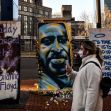On day one of Derek Chauvin’s trial for the murder of George Floyd, new information was introduced. Instead of the 8 minutes, 46 seconds the world had assumed was the duration that Chauvin’s knee was on Floyd’s neck, prosecutors say it was actually 9 minutes, 29 seconds — 43 seconds longer than first reported.
The primary questions in the murder trial are these:
1. What killed George Floyd?
2. Did Chauvin use excessive force?
Although the defense argues that Floyd’s drug use and health conditions caused him to die from cardiac arrhythmia, prosecutors insist that Chauvin killed Floyd.
Opening Statements
During opening statements, prosecutors showed the video of Chauvin kneeling on Floyd’s neck as proof of Chauvin’s use of excessive force. Jerry Blackwell, a Minneapolis lawyer working the case pro bono, delivered the opening argument.
“You will learn that on May 25, 2020, Mr. Derek Chauvin betrayed this badge when he used excessive and unreasonable force upon the body of Mr. George Floyd. That he put his knee upon his neck and his back, grinding and crushing him until the very breath . . . until the very life was squeezed out of him,” he said. “I will tell you that you can believe your eyes that it’s a homicide.”
Blackwell’s hour-long opening statement included insistence that Floyd was “completely in the control of the police” during the situation.
Blackwell highlighted the Hennepin County Medical Examiner’s findings of cause of death in the autopsy report: “cardiopulmonary arrest complicating law enforcement subdual, restraint, and neck compression.” Blackwell went on to say, “You will learn that he did not die from a drug overdose. He did not die from an opioid overdose.”
Trace amounts of fentanyl and methamphetamine were found in Floyd’s body but were not listed as the cause of death. That Floyd struggled with opioid addiction is known.
Charles Coleman, Jr., a former prosecutor and civil rights lawyer, called the video “damning evidence.” He said, “The defense knew that going in. The prosecution knew that, of course. And that’s going to be something that they hammer home to try to keep this as simple and straightforward for the jury as possible.”
Defense attorney Eric Nelson, in his opening statement, told the jury that Floyd died from “a cardiac arrhythmia that occurred as a result of hypertension, coronary disease, ingestion of methamphetamine and fentanyl, and the adrenaline throwing, flowing through his body, all of which acted to further compromise an already compromised heart.” He added that Andrew Baker, Hennepin County Medical Examiner, related no “telltale signs of asphyxiation” when he told law enforcement about his autopsy findings.
Calling attention to Baker’s interviewers with prosecutors and the FBI, Nelson told the jury that the prosecutors were “not satisfied with Dr. Baker’s work” so they consulted “numerous physicians to contradict Dr. Baker’s findings.”
Nelson further said, “When you review the actual evidence and when you hear the law and apply reason and common sense, there will only be one just verdict, and that is to find Mr. Chauvin not guilty.” He argued that Chauvin followed the Minnesota Police Department’s use of force policy. “You will learn that Derek Chauvin did exactly what he had been trained to do for the course of his 19-year career,” he said.
Nelson also took pains to highlight the extent of the investigation, citing hundreds of interviews with civilian witnesses, first responders on scene, and other Minneapolis Police Department officers. “Common sense is the application of sound judgment based upon a reasoned analysis, and that’s what this case is ultimately about,” he said. “It’s about the evidence in this case . . . there is no political or social cause in this courtroom.”
The defense attached blame to the crowd growing around the arrest scene, and Nelson said the crowd distracted the officers in Floyd’s arrest. “There are people across the street, there are cars stopping, people yelling, there is a growing crowd in what officers perceived to be a threat. They’re called names. I heard them this morning. A f___ing bum. They’re screaming at them, causing the officers to divert their attention from the care of Mr. Floyd to the threat that was growing in front of them.”
Witnesses
The prosecution’s first witness was Jena Lee Scurry, the 911 dispatcher who took the call. She acknowledged that she is not a police officer and is not trained in the Minneapolis Police Department’s use of force standards, but said that what she saw through her dispatch center video feed led her to call a supervising sergeant to report the incident. She first thought her screen was frozen, but then saw people moving in the background and thought something might be wrong.
“I don’t know. You can call me a snitch if you want to, but we have the cameras up for 320’s call . . . I don’t know if they had to use force or not, but they got something out of the back of the squad and all of them sat on this man. So I don’t know if they needed you or not, but they haven’t said anything to me yet.” This quote comes from the call she made to the sergeant that was played for the court.
Scurry was a seven-year veteran dispatcher and said she had never made a similar call before in her career.
Other witnesses were 33-year old Donald Williams, who was present at the scene, and 23-year old Alisha Oyler. Williams told Chauvin on the scene that he was holding Floyd in a “blood choke.” Williams has trained police officers in mixed martial arts at a gym. He said Chauvin used his knee in a “shimmy,” a move that cuts off airflow.
Williams testified that he heard Floyd. “Hearing George on the ground pretty much pleading for his life saying he’s sorry, ‘I can’t breathe, I want my mom, just please let me up,’ things like that.” He went on to say, “The more you see Floyd fade away, slowly fade away. He was going through distress because of the knee. He vocalized it, that ‘I can’t breathe, I need to get up, and I’m sorry,’ and his eyes slowly roll to the back of his head.”
Presiding Judge Peter Cahill admonished Williams to stick to the facts, and not to give his opinion about what happened. “You’re kind of going beyond it by not being responsive to answer, talking about killing him and things like that. It’s just that there are certain things that I’m allowing you to testify to and that’s fine but we ask that you be very careful that we don’t let you go beyond those, otherwise I’ll just have to tell the jury to disregard.”
Witness Alisha Oyler worked at the gas station across the street from the scene. She captured moments of the situation on her phone. When asked why she filmed the arrest at length, she responded, “It’s always the police — they’re always messing with people. And it’s wrong, and it’s not right.”
Burden of Proof
The prosecution is required to prove Chauvin’s culpability beyond a reasonable doubt. Because more than one charge is in play, the prosecutors have a better chance of getting a conviction.
The third-degree murder charge has a lesser standard of proof than the second-degree murder charge; for Chauvin to be convicted of murder in the third degree, the prosecution need only prove that Chauvin acted without the intent to kill Floyd, but that he did so in an “eminently dangerous” way “evincing a depraved mind, without regard for human life.”
A second-degree murder conviction can be classified as either intentional or unintentional. Chauvin’s charge is for unintentional second-degree murder. Prosecutors must prove beyond a reasonable doubt that Chauvin killed Floyd unintentionally while kneeling on his neck. A part of the proof would be showing that Chauvin had the intent to commit aggravated assault and battery against Floyd.
To obtain a manslaughter conviction, the prosecution would need to prove that Chauvin “consciously” acted in a manner that could have caused Floyd’s “death or great bodily harm.”
The Jury
Jurors will be allowed to go home each night, but Judge Cahill will sequester them for deliberations. His directions to them were “Please avoid news coverage. As I said about this case, whether it’s in newspapers, radio, television, social media or any other media, please disable any news feeds that might show up on your social media accounts that might report on this case.” He advised them not to discuss the trial or their role in it but said they could use the Internet. They are not to discuss the trial.






